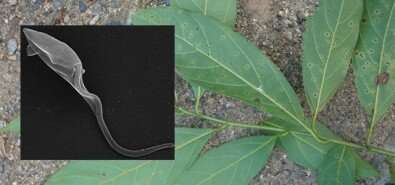Biocompound from Atlantic Rainforest combats leishmaniasis and Chagas disease

Natural compounds isolated from Nectandra leucantha, a neotropical tree species belonging to the laurel family (Lauraceae) and endemic to the Atlantic Rainforest biome in Brazil, where its common name is canela-seca or canela-branca, could result in new medications for the treatment of visceral leishmaniasis and Chagas disease.
In a study supported by São Paulo Research Foundation—FAPESP, researchers at Adolfo Lutz Institute (IAL) in São Paulo City found that neolignans derived from N. leucantha displayed bioactivity against parasites of the genus Leishmania and against Trypanosoma cruzi, the parasite that causes Chagas. These diseases affect millions of people in Brazil and other developing countries.
The findings are published in Scientific Reports and European Journal of Medicinal Chemistry.
"The compounds proved to be highly potent against Leishmania infantum, which causes visceral leishmaniasis, and T. cruzi," André Gustavo Tempone told. Tempone is a professor at IAL, head of its Parasitology and Mycology Center, and principal investigator for the study.
The IAL research group has spent several years seeking compounds from the Atlantic Rainforest, a biodiversity hotspot that could result in the development of new drugs to combat neglected diseases caused by infectious agents or parasites that mainly affect poor people.
The neolignans were isolated during a project conducted in collaboration with João Henrique Ghilardi Lago, a professor at the Federal University of the ABC (UFABC) also in Brazil.
Their effects on immune system cells were evaluated and demonstrated in a project conducted in collaboration with colleagues at Ohio State University in the United States and also supported by FAPESP.
Most recently, Tempone and his group synthesized 23 new neolignan derivatives as part of a project conducted in collaboration with Ed Anderson, Professor of Organic Chemistry at the University of Oxford in the United Kingdom. The project was supported by FAPESP via its program São Paulo Researchers in International Collaboration (SPRINT).
"One of the constraints on the development of new drugs to treat neglected diseases is the difficulty of finding partners to synthesize promising compounds," Tempone said. "Our collaboration with Professor Ed Anderson's group at Oxford enabled us to take this step."
The researchers evaluated the effects of the neolignan derivatives in L. infantum cells. Their analysis showed that four of the compounds reached the parasite's mitochondria, a potential molecular target for an antileishmaniasis drug.
While humans can have up to 2,000 mitochondria per cell, L. infantum cells have a single mitochondrion, Tempone explained. "We found that the compounds acted potently on the parasite's mitochondria," he said.
The compounds caused a sharp rise in intracellular calcium levels, which disrupted mitochondrial metabolism and led to cell death.
"Our hypothesis is that the compounds interfered drastically with intracellular calcium release and prevented mitochondria from producing ATP [adenosine triphosphate], the parasite's main source of energy," Tempone said.
The compounds also impaired the cell life cycle, triggering a mechanism similar to apoptosis (programmed cell death) and affecting DNA replication. Similar effects were observed in trials with T. cruzi.
"We also found that the mitochondria of T. cruzi cells underwent changes at the start of incubation of the compounds with the parasite," Tempone said.
The researchers plan to optimize the compounds to assure their adequate bioavailability in the organism. This is a key step in evaluating drug effectiveness and safety before advancing to in vivo trials. More than 90% of drug candidates tested in vitro (in cultured cells) fail to pass trials in animals, according to Tempone.
"The compounds will be optimized by means of medicinal chemistry so that we can increase the success rate in studies using an animal model," he said.
"The compounds we obtained are already highly promising prototypes, however. They combat leishmaniasis and comply with the recommendations of the Drugs for Neglected Diseases initiative [DNDi, an international non-profit organization focused on drug research and development]."
One of the DNDi's recommendations is that promising compounds for the treatment of neglected diseases should be easy to synthesize.
"Synthesis of the compounds we're studying is simple and completed in five stages. Additionally, they're inexpensive," Tempone said.
More information: Daiane D. Ferreira et al, Dehydrodieugenol B derivatives as antiparasitic agents: Synthesis and biological activity against Trypanosoma cruzi, European Journal of Medicinal Chemistry (2019). DOI: 10.1016/j.ejmech.2019.05.001
Maiara Amaral et al. A semi-synthetic neolignan derivative from dihydrodieugenol B selectively affects the bioenergetic system of Leishmania infantum and inhibits cell division, Scientific Reports (2019). DOI: 10.1038/s41598-019-42273-z


















